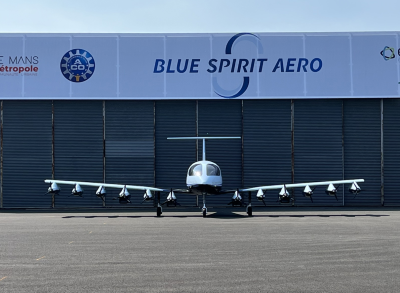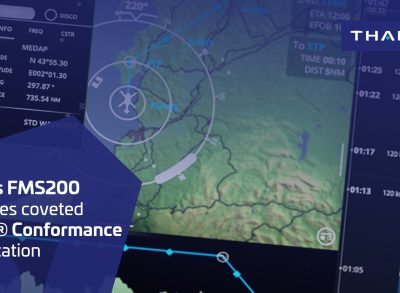SES and Thales have taken inflight connectivity to a new level, successfully demonstrating uninterrupted access to high-throughput broadband applications for the first time over a platform supporting multi-orbit interoperability, switching seamlessly between SES’s geostationary (GEO) and O3b medium earth orbit (MEO) satellite beams. The demo flight from Melbourne, Florida to the Atlantic coast of Nicaragua saw dozens of switches successfully completed between GEO and MEO beams, and between multiple MEO satellites within a beam, using the Hughes JUPITER(TM) Aeronautical system high performance airborne modem system, SES and Thales announced today.
Engineers aboard the test flight were able to simultaneously use a broad range of bandwidth-hungry services demonstrating rates in excess of 265 Mbps via the Thales FlytLIVE connectivity network featuring the Hughes JUPITER System and a Hughes ModMan integrated with the ThinKom Ka2517 phased-array airborne antenna. Leveraging the same high-powered, low-latency O3b MEO capacity that has already redefined connectivity at sea, the engineers were able to demonstrate quality and reliable delivery of 4K video streaming, super-fast social media networking, e-commerce transactions, audio conferencing, interactive gaming and web browsing on-board the Gulfstream G-III aircraft.
The seamless integration of SES’s satellite networks offers customers unprecedented redundancy, leveraging two diverse systems to ensure uninterrupted service: GEO for network resiliency and proven fibre-like high-performance from O3b MEO. The O3b constellation of 20 MEO satellites is manufactured by Thales Alenia Space. SES expects upcoming GEO/MEO trials to deliver even higher connectivity speeds, a precursor of things to come for both commercial and business aviation as SES nears the scheduled 2021 launch of its O3b mPOWER system.
O3b mPOWER is SES’s fully funded, next-gen, ultra-high-capacity, low-latency, and highly flexible MEO satellite-based data communications system. A scalable terabit-level constellation with 35,000 fully-shapeable and steerable beams, O3b mPOWER is backwards-compatible with the first-generation O3b MEO system and can deliver a whole new level of customisation that allows bandwidth to be tailored to specific passenger and operational connectivity requirements over certain travel routes and regions.
SES’s interoperable GEO/MEO platform has already been validated in the cruise industry, revolutionising the guest experience at sea by delivering up to 1 Gpbs per ship to major cruise lines around the world with its managed MEO- and GEO-based connectivity service. The test flight paves the way for SES to similarly redefine the connected air passenger experience by enabling different operational models, including blanketing of large dense traffic routes, bolstering of capacity around major airports, or even following individual aircraft from take-off to landing – all at record speeds and with low latency.
“The world’s first low-latency, high performance broadband aero experience is closer than ever before with this tremendously successful demonstration of MEO and GEO interoperability. Driving scale and performance into our customers’ networks is fundamental in delivering the best passenger experience in the skies. Our cruise customers have long experienced the benefits of the combined power that low latency MEO- and GEO-based connectivity brings to network performance and resilience. This innovation is now on its way for connected commercial and business air travel,” said Steve Collar, CEO of SES. “We are gearing ourselves up for the launch of O3b mPOWER and now, with a demonstrated ability to roam seamlessly across our GEO and MEO networks, our customers will enjoy unprecedented speed and performance from our O3b constellation, while also benefiting from the scale and reach of our GEO fleet.”"The cutting edge products Thales is bringing to the market with both internal developments, as well as leaders in the industry, is exciting for the future of our FlytLIVE connectivity solution,” said Philippe Carette, Chief Executive Officer, Thales InFlyt Experience. “This proof-of-concept demonstration introduces an operational Hybrid network that will provide satellite network redundancy with continuous and seamless high-speed internet in areas otherwise hindered by congestion. The system offers a consistent passenger experience gate-to-gate; Ka-band coverage on routes where GEO satellites do not currently exist; and is fully compatible with the new SES-17 satellite built by Thales Alenia Space that is scheduled to enter commercial service in early 2021.”





